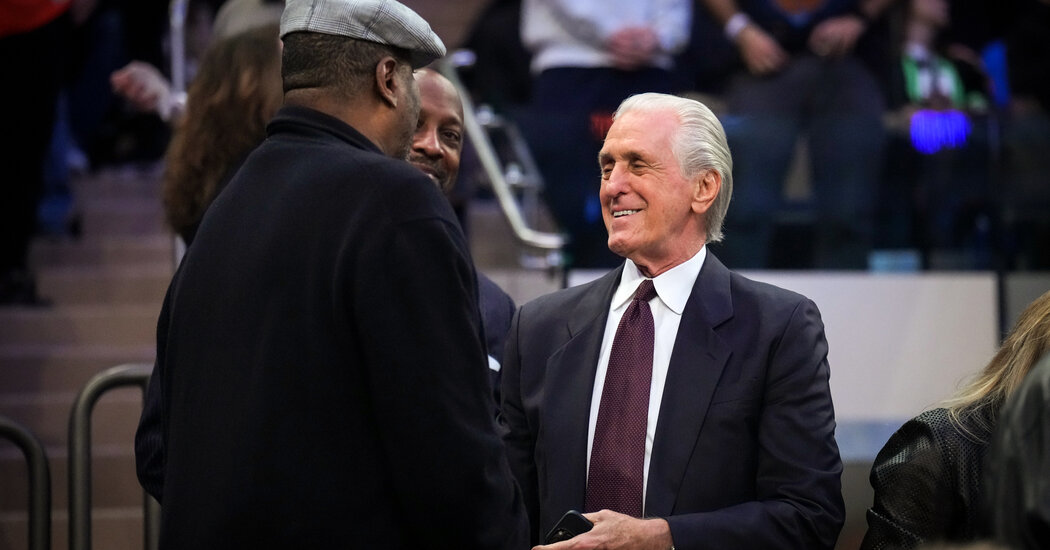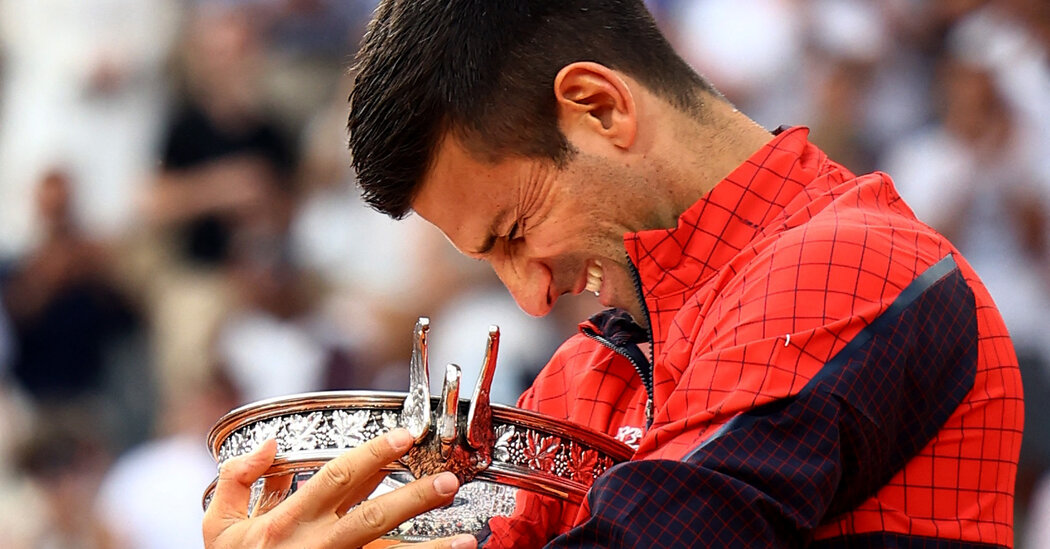Carl Erskine Will Receive Hall of Fame’s Buck O’Neil Award
It is the first inning, you might say, and Carl Erskine does not have his best stuff. A camera crew has set up in his living room, and a filmmaker, Ted Green, gently tries to guide Erskine through a short speech. This is hard work for the old Brooklyn Dodger, who needs several takes.
Erskine apologizes; he is not at his sharpest, he says. But when he gets it, he nails it, as he was bound to do. There has always been something inviting about Erskine, a welcoming look that draws you in warmly and melts away the decades.
“He’s a 96-year-old guy,” Green says, “with 12-year-old eyes.”
Soon the eyes are dancing and the memories come rushing back. An interview starts and the game rolls along, like a no-hitter at Ebbets Field (he threw two), complete with the playing of “Take Me Out to the Ball Game” — on harmonica. Erskine keeps one beside the lamp on the end table, an out pitch he can always reach.
“When we have music, he’ll pick up the harmonica,” says Betty Erskine, 95, from her blue easy chair on the other side of the table from her husband. “If it’s in the wrong key, he lays it back down. But if it’s right, he’ll play along.”
Erskine plays an original piece, “The Stan Musial Blues,” that he wrote for the hitter he faced more than any other, often without luck. Musial, who died in 2013, played his own harmonica at the Hall of Fame ceremonies every July. Erskine is not a member, but this weekend he will have his day in Cooperstown, N.Y.
On Saturday, a day before Fred McGriff and Scott Rolen are inducted into the Hall, Erskine will receive the Buck O’Neil Lifetime Achievement Award, named for the pioneering Negro leagues star, which is given every three years for positive contributions to baseball’s impact on society.
Deep in winter for the last of Dodgers players chronicled in the book “The Boys of Summer,” Erskine remembers it all with childlike wonder.
“As a kid growing up, your imagination takes you to a lot of places, and so I always dreamed of places like this,” said Erskine, the only living player from the 1955 World Series, when Brooklyn won its only crown. “Never really thought it would happen — but then it did happen, and that made it so amazing. It’s like, ‘Was that me?’”
As a minor leaguer, Erskine talked curveball grips with Mordecai Brown, who was better known as Three Finger Brown. As a young major leaguer on Oct. 3, 1951, he bounced the curve while warming up in the bullpen at the Polo Grounds in Upper Manhattan. The Dodgers then called for another pitcher, Ralph Branca, who gave up Bobby Thomson’s famous pennant-winning homer for the Giants.
Stardom followed for Erskine: a 20-win season, a 14-strikeout game in the World Series (Mickey Mantle fanned four times), the no-hitters. He made the first start for the Dodgers in Los Angeles in 1958 and threw a strike with the first pitch.
Erskine’s arm finally gave out the next June, a time so distant that the union had 49 states and the majors just 16 teams. He and Betty had seen so much history, with so much more to come, and in 1960, they decided to experience it all in Anderson, Ind., their shared hometown.
“They’d say, ‘Where is Anderson?,’ and I’d say, ‘Well, it’s on the White River between Moonville and Strawtown,’” Erskine said, laughing softly. “Anderson was always just a good, solid place to raise your kids.”
That decision, as much as his baseball career, pointed Erskine on the path to this weekend’s honor. His original postcareer plan had been to move to New York and work as an athletic wear representative for Van Heusen, the apparel company. But the family stayed in Anderson when Jimmy, the fourth Erskine child, was born with Down syndrome in April 1960, a time when many families struggled with society’s attitudes toward children with intellectual disabilities.
“The assumption right in the beginning was, of course, you’re going to take him to some institution,” Erskine said. “And Betty says, ‘No, no, he goes home with us.’ And that was it from the beginning, Day 1. So we never considered anything but Jimmy going with us.”
Erskine sold insurance, worked as a bank president and coached baseball at Anderson College. Jimmy went everywhere with the family — to dinner, to church, to his siblings’ athletic events. He attended public school in Anderson, where an elementary school was named in the family’s honor in 2004.
Jimmy, now living with a caretaker, retired recently after working 20 years at an Applebee’s restaurant in Anderson. He visits his parents’ home twice a week.
“He’s 63, and they had told us he’d live to be in his 30s,” Betty said. “We feel like we were given an angel.”
The Erskines became a trusted resource for families with similar challenges; Gary, their second child, said several family friends went into careers in special education. Carl volunteered with the Special Olympics for more than four decades — recruited by its founder, Eunice Kennedy Shriver — and a vocational training program in Muncie is named in his honor.
In speeches, Erskine would bring a World Series ring and a Special Olympics medal, noting the greater significance of the latter. Along the way he came to recognize the similarities between his Brooklyn teammate Jackie Robinson and Jimmy. Both thrived in settings that would once have shunned them. His short book about them, “The Parallel,” is being developed for use in Indiana public schools.
When Erskine became involved with a youth organization, the Wildcat Baseball League — motto: “Everybody makes the team” — in the 1960s, Robinson went to Fort Wayne to help promote it, with Ted Williams and Bob Feller.
“I know that anything that Carl Erskine would be associated with has to be a very fine thing,” Robinson told the crowd. “Carl talked about our relationship on the Brooklyn baseball club, and it’s a friendship that I’ll cherish, and I’ll always cherish, for as long as I can remember.”
Green, the filmmaker, uses that clip in his Erskine documentary, “The Best We’ve Got,” which had its premiere last summer in Anderson and will be shown at the National Baseball Hall of Fame and Museum this month. The title comes from Mitch Daniels, the former governor of Indiana, who used it while giving Erskine the state’s highest honor, the Sachem Award for achievement and moral virtue, in 2010.
“For the characteristics we’re talking about, the ones that I would like to think people here — not just here, but in a place like Indiana — respect and revere, he’s the best,” Daniels said in an interview. “He was living these things decades before people invented these buzzwords. They were somehow either born and instilled in him.”
They were instilled, in a graphic way, when Erskine’s father, Matt, took him to Marion, Ind., in 1930, the morning after a mob had stormed a jailhouse and hung two Black prisoners. Matt Erskine wanted his son to see the effects of hate.
The sight of a bare tree branch and remnant of a noose has been seared in Carl Erskine’s consciousness ever since. In a state that once counted about 30 percent of the male population as dues-paying members of the Ku Klux Klan, Erskine grew up with a Black best friend, Johnny Wilson — a distinction, he said, that should earn him no special accolades.
“I lived in a mixed neighborhood and I knew a lot of outstanding Black families, hard-working families, and Johnny was a buddy,” Erskine said. “I ate at his house, he ate at my house, and we were just very, very close. I never noticed the color of the skin. It never played a part in our relationship. So it’s hard for me to take any credit for that, because it just came natural for me.”
On the top shelf of a cabinet in the Erskines’ living room is a figurine Wilson gave to his old pal: two boys — one Black, one white — on a bench in baseball uniforms. Tucked behind it is Wilson’s note: “Like when we were kids.”
Wilson died in 2019. Roger Craig, the last Dodger besides Erskine who played in that 1955 World Series, died last month. Two of Erskine’s children, Gary and Susie, will represent him in Cooperstown, part of a sprawling family that includes five grandchildren and 11 great-grandchildren, including a girl named Brooklyn.
Erskine’s name will be on permanent display at the Hall of Fame by the Buck O’Neil statue, just down a hallway and around the corner from the plaque gallery. That room honors the most hallowed Brooklyn names — Robinson, Campanella, Snider, Reese, Hodges and more — and, to Erskine, sends a subtle but powerful message he has spent his life promoting.
“There’s one key factor about the plaques around that room at the Hall of Fame,” Erskine said. “They’re all bronze. They’re all the same color.”


